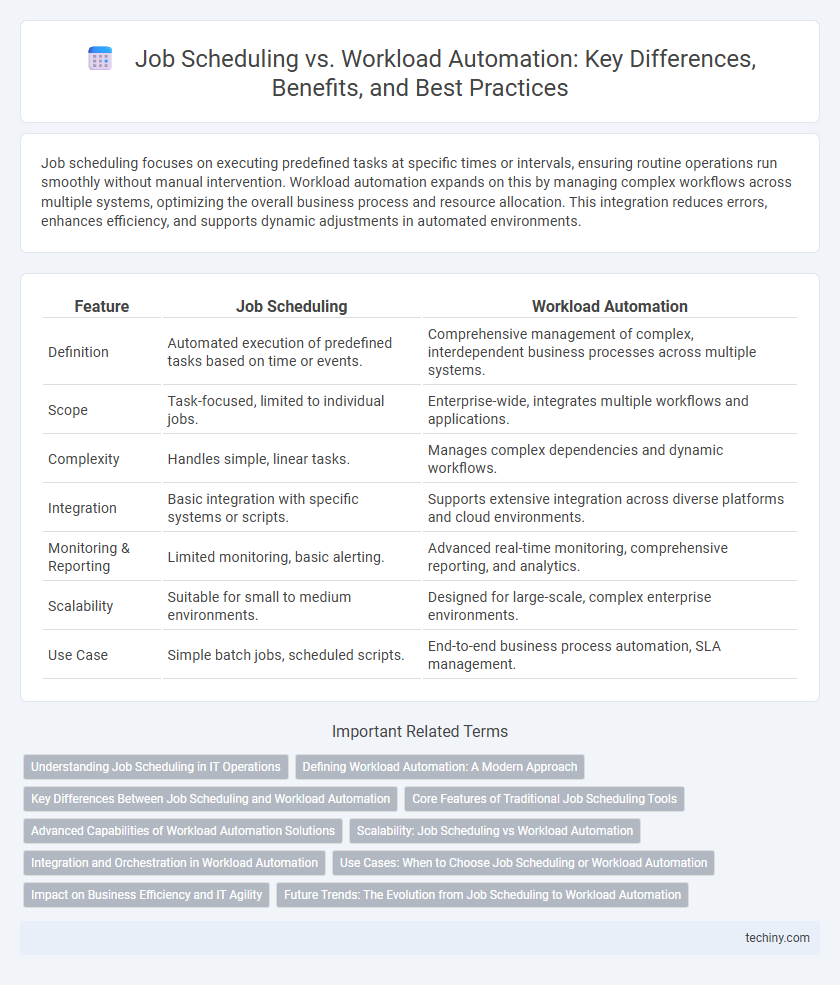Job scheduling focuses on executing predefined tasks at specific times or intervals, ensuring routine operations run smoothly without manual intervention. Workload automation expands on this by managing complex workflows across multiple systems, optimizing the overall business process and resource allocation. This integration reduces errors, enhances efficiency, and supports dynamic adjustments in automated environments.
Table of Comparison
| Feature | Job Scheduling | Workload Automation |
|---|---|---|
| Definition | Automated execution of predefined tasks based on time or events. | Comprehensive management of complex, interdependent business processes across multiple systems. |
| Scope | Task-focused, limited to individual jobs. | Enterprise-wide, integrates multiple workflows and applications. |
| Complexity | Handles simple, linear tasks. | Manages complex dependencies and dynamic workflows. |
| Integration | Basic integration with specific systems or scripts. | Supports extensive integration across diverse platforms and cloud environments. |
| Monitoring & Reporting | Limited monitoring, basic alerting. | Advanced real-time monitoring, comprehensive reporting, and analytics. |
| Scalability | Suitable for small to medium environments. | Designed for large-scale, complex enterprise environments. |
| Use Case | Simple batch jobs, scheduled scripts. | End-to-end business process automation, SLA management. |
Understanding Job Scheduling in IT Operations
Job scheduling in IT operations involves the systematic execution of predefined tasks at specified times or intervals, ensuring routine processes run efficiently without manual intervention. It primarily handles repetitive jobs like backups, batch processing, and system maintenance by automating task initiation based on time or event triggers. Effective job scheduling reduces operational errors and downtime, streamlining IT workflows through precise timing and resource allocation.
Defining Workload Automation: A Modern Approach
Workload Automation is an advanced IT practice that manages and coordinates batch jobs, application processes, and data flows across complex systems and cloud environments, ensuring seamless and efficient operations. Unlike traditional job scheduling, Workload Automation integrates analytics, event-driven triggers, and cross-platform orchestration to optimize resource utilization and reduce operational risks. This modern approach enables businesses to achieve end-to-end visibility, accelerate workflows, and support dynamic, hybrid infrastructures with robust scalability and compliance.
Key Differences Between Job Scheduling and Workload Automation
Job scheduling primarily focuses on executing predefined, individual tasks at specific times, often relying on simple triggers and fixed sequences. Workload automation encompasses a broader scope by integrating complex dependencies, multi-application workflows, and dynamic resource management to optimize end-to-end business processes. Unlike job scheduling, workload automation offers real-time monitoring, predictive analytics, and cross-platform orchestration for enhanced operational efficiency.
Core Features of Traditional Job Scheduling Tools
Traditional job scheduling tools primarily focus on executing predefined batch jobs at specified times or intervals, ensuring basic task automation and system resource management. Core features include calendar-based scheduling, job dependencies, and limited real-time monitoring or alerting capabilities. These tools often lack advanced workload automation functionalities such as dynamic resource allocation, event-driven triggers, and comprehensive analytics for optimizing enterprise IT operations.
Advanced Capabilities of Workload Automation Solutions
Workload automation solutions offer advanced capabilities such as dynamic workload balancing, predictive analytics, and event-driven triggers that surpass traditional job scheduling features. These systems integrate cross-platform workflows, enabling seamless orchestration across cloud, on-premises, and hybrid environments. Real-time monitoring and intelligent exception handling further enhance operational efficiency and reduce manual intervention.
Scalability: Job Scheduling vs Workload Automation
Job scheduling manages predefined tasks within limited systems, offering basic scalability suited for smaller workloads. Workload automation integrates diverse processes across hybrid environments, enabling dynamic scaling that supports complex enterprise-level demands. Enhanced scalability in workload automation ensures optimal resource utilization and uninterrupted performance during peak business operations.
Integration and Orchestration in Workload Automation
Workload automation enhances job scheduling by integrating diverse IT systems, applications, and data sources into a unified framework, enabling seamless orchestration across complex workflows. It supports event-driven triggers and conditional logic to dynamically manage dependencies and optimize resource utilization in real-time. This integration and orchestration capability distinguishes workload automation as a strategic solution for end-to-end process automation beyond basic job execution.
Use Cases: When to Choose Job Scheduling or Workload Automation
Job scheduling suits straightforward, repetitive tasks like batch processing and system backups, ensuring precise timing and resource allocation. Workload automation excels in complex environments requiring coordination across multiple applications, dynamic workflow adjustments, and real-time event-driven triggers. Selecting the right solution depends on job complexity, integration needs, and organizational scalability requirements.
Impact on Business Efficiency and IT Agility
Job scheduling automates repetitive tasks based on predefined rules, ensuring timely execution but with limited flexibility. Workload automation integrates cross-platform processes, optimizing resource utilization and enabling dynamic adjustments to workloads in response to changing business demands. This comprehensive approach enhances business efficiency by reducing operational delays and improves IT agility by allowing faster adaptation to evolving priorities and complex workflows.
Future Trends: The Evolution from Job Scheduling to Workload Automation
Job scheduling is evolving into workload automation by integrating AI-driven analytics and real-time monitoring to enhance efficiency and predictive capabilities. Future trends highlight seamless orchestration across hybrid cloud environments, enabling dynamic resource allocation and proactive incident management. This evolution supports businesses in achieving greater scalability, agility, and end-to-end automation across complex IT ecosystems.
Job Scheduling vs Workload Automation Infographic

 techiny.com
techiny.com